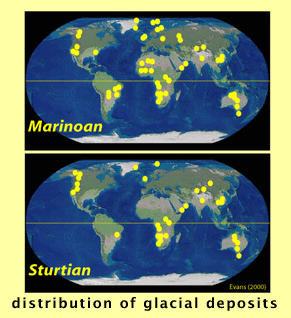The case for snowball earths is based on different lines of evidence.
- The global distribution of
 Sturtian and Marinoan glacial deposits, and
the broad synchroneity of the latter based on seawater carbon isotope anomalies
consistently framing the glacial strata.
Sturtian and Marinoan glacial deposits, and
the broad synchroneity of the latter based on seawater carbon isotope anomalies
consistently framing the glacial strata.
- The association of glacial or glacial marine deposits with thick carbonate
(limestone or dolostone) successions, which occur preferentially in the
warmest parts of the surface ocean.
- Deposition of glacial or glacial marine strata close to the paleo-equator
during the Marinoan, Sturtian and Makganyene glaciations, indicated by a
growing body of reliable paleomagnetic data from different regions.
- Paleomagnetic data suggesting multiple reversals of the geomagnetic
field, implying hundreds of thousands to millions of years, during the Marinoan
glaciation near the paleo-equator.
- Paleomagnetic data showing that thick Proterozoic carbonate successions
formed at low-latitudes, indicating that the meridional climate gradient
was not reversed (warm poles and cold equator) as would be true if the rotation
axis had been highly oblique (to the ecliptic) as earlier proposed to explain
low-latitude glaciation.
- Sedimentary iron (± manganese) oxide deposits (banded iron formation)
found exclusively in glacial marine strata after 1.9 Ga, indicating widespread
anoxia (consistent with an ice-covered ocean) and an increase in the ratio
of Fe to S entering the ocean (consistent with ice-covered continents).
- Deep flooding of previously shallow-water shelves and platforms after
the Sturtian and Marinoan meltdowns, sustained after isostatic readjustments,
reflecting slow tectonic subsidence over millions of years under the ice.
- The deposition of post-glacial "cap carbonates" with unusual
sedimentary structures on continental margins and inland seas globally
in the aftermaths of the Sturtian and Marinoan glaciations. Regional-scale
glaciations
lack cap carbonates or they are poorly developed. Their origin remains
controversial but they are predicted to occur in the greenhouse aftermath
of a snowball
earth.
- Part-per-billion concentrations of the platinum group element iridium
found at the base of Sturtian and Marinoan cap carbonates are interpreted
as an extraterrestrial dust component trapped in ice for millions of years
and released upon deglaciation. This new result (Bodiselitsch et al., 2005)
awaits confirmation and testing, but the suggested time scale (~12 million
years assuming an extraterrestrial flux equal to that of the last 65 million
years) for glacial entrapment is suggestive of a snowball earth.
- Boron isotope data for carbonates deposited before and after the Marinoan
glaciation, which suggest a large decrease in seawater pH, consistent with
a buildup of CO2 acid. A decrease in continental weathering relative to
mid-ocean ridge hydrothermal exchange should shift the boron isotope composition
of seawater in the direction opposite to that observed, so this is not a
viable alternative explanation. This is another new result (Kasemann et
al., 2005) that requires confirmation and further analysis.